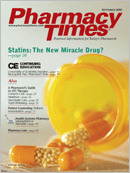Publication
Article
Pharmacy Times
Using Race to Choose Drug Therapy
Author(s):
In an article that appeared inPharmacy Times in February 2004, Idescribed gender-specific drug effects.1 I explained that one of the reasonsfor these different effects is thatmen and women metabolize drugs differently.
Differences also exist in certain diseaseincidences between the sexes andamong racial and ethnic groups. Forexample, the age-adjusted risk for incidentcoronary heart disease (CHD) ishigher in African-American womenaged 20 to 54 years than in Caucasianwomen of the same age and lower inAfrican-American men than in Caucasianmen of the same age.2 In addition,there are differences in the associationbetween hypertension and CHDby sex and race.3 According to theAmerican Heart Association, cardiovascular(CV) diseases rank as the number-1killer of African Americans, claimingthe lives of >37% of the >285,000blacks who die each year. It is estimatedthat ~30% of non-Hispanic whitemen and 24% of non-Hispanic whitewomen have CV disease. Among non-Hispanic blacks, ~41% of men and 40%of women have CV disease.
Because of the disparity, it wouldappear reasonable to use race as a factorwhen choosing drugtherapy for patients.This disparity was madeclear when the results of2 studies were publishedin a major medical journalseveral years ago.The reports addressedthe effects of race on theresponse to drugs of 2important classes usedin heart failure. One wasa beta-blocker withalpha-adrenergic blockingeffects (carvedilol),4and the other was anangiotensin-convertingenzyme (ACE) inhibitor(enalapril).5 Both drugs had beenshown in multicenter, randomized,controlled trials to be effective forpatients with heart failure. The characteristicsof the patients most or leastlikely to benefit were poorly defined,however, so physicians lacked guidanceas to the optimal therapy forpatients of different racial backgrounds.6 It was demonstrated thatcarvedilol appears to reduce the risk ofdeath or hospitalization in both blackand nonblack patients, whereas theACE inhibitor appears to reduce therates of hospitalization only in whites.
RationaleFor the purposes of this article, theterms race and ethnicity will be usedinterchangeably. Traditionally, racerefers to differences of biology, ethnicityto differences of culture and geographicorigin.7
Racial differences in drug responseshave now been described for a range ofdrugs, and they reflect genetic differences,environmental differences, andfundamental differences in the pathogenesisof diseases.6 Many of the geneticdifferences are based on varying distributionsof polymorphisms in drugreceptors or drug-metabolizingenzymes among different racial andethnic groups. (A polymorphism is agenetic variant.) For example, CYP2D6is the cytochrome P-450 enzymeresponsible for the metabolism of betablockers.Black Americans have a highfrequency of a CYP2D6 allele thatencodes an enzyme with impairedactivity, which could affect alphaadrenergicblockade and result in toxiceffects.6 (An allele is an alternativeform of a gene that can occupy a particularlocation on a chromosome.)Black patients may lack nitric oxide, achemical that plays a major role indilating blood vessels. In addition,there appear to be racial differences incardiac structure and function inuntreated black patients with hypertension,when compared with untreatedwhite patients.8 These differencesmay or may not have an effect on theuse of drugs to treat this disorder.
Many gene variants are known toaffect drug response, so it should bepossible to predict drug response onthe basis of race. Variants, however,that are present in one ethnic groupare usually present in others as well.9 Ithas been claimed that at least 29 medicines,or combinations of medicines,have differences in either safety or,more commonly, efficacy among racialor ethnic groups. (An example is therecent finding that subgroups of Asianpatients were observed with increasedrosuvastatin drug levels. This was oneof the reasons that the FDA requiredthe manufacturer to make a lowerdosage form available.)
In many cases, any reported differencesin safety and efficacy claims forcertain drugs are controversial.10 Thehope is that the emerging science ofgenomics will offer a way to use race asa means to understand the causes ofdisease and to choose optimal drugtherapy.11
Race-Specific Therapy
Remarkable progress has already beenmade with certain drugs for CV disease.For the first time, a drug designed for"race-specific" therapy exists.12 Theproduct, called BiDil, is a combinationof the antioxidant hydralazine (37.5 mg)and the nitric oxide donor isosorbidedinitrate (20 mg). These 2 drugs havebeen used for years to treat heart-relatedproblems. NitroMed, the manufacturerof BiDil, has obtained the first-everpatent for preexisting drugs for a new,race-specific use.
The manufacturer submitted a newdrug application to gain FDA approvalto market BiDil specifically as a heartdrug for blacks. The reason is that thesponsor chose to test the drug in amajor study exclusively limitingenrollment to black patients. Thestudy, which involved >1000 patientsat ~170 study sites, was stopped earlyafter initial results showed a significantlyhigher mortality rate in theplacebo group. At the time the trial washalted, 54 patients had died in theplacebo group (10.2%) and 32 patientsin the combination-therapy group(6.2%).13 The action followed unanimousrecommendations from both theindependent Dataand Safety MonitoringBoard and theSteering Committeefor the trial.
Despite the results,critics contend that itis irresponsible andunscientific to implythat BiDil works betteron people of onerace than of another.It also means that anumber of nonblackpatients who mightbenefit from the drugwill not receive it and that blackpatients may assume that it will helpeven if it will not. This could, ofcourse, lead for the first time to "racialprofiling" in medicine. There is alsothe danger that, as other drugs emergewith better results in one racial groupor another, some pharmaceutical companiesmay be tempted to qualify themas racial medicines rather than broader-based therapies.14
Supporters think that the drug is asignificant advance for treating blackheart failure patients and that the mostimportant consideration should besaving lives. The Association of BlackCardiologists (a joint sponsor of thestudy) and the Congressional BlackCaucus have lauded the researcheffort.15
This is a real conundrum, but it wasresolved when the FDA approved thedrug on June 23, 2005, calling it a steptoward the promise of personalizedmedicine. The Indications and Usagesection of the package insert, in part,states that BiDil is indicated for thetreatment of heart failure as an adjunctto standard therapy in self-identifiedblack patients to improve survival, toprolong time to hospitalization forheart failure, and to improve patient-reportedfunctional status.
Mr. Sherman is president of ShermanConsulting Services Inc.
For a list of references, send a stamped,self-addressed envelope to:References Department, Attn. A. Stahl, PharmacyTimes, 241 Forsgate Drive, Jamesburg,NJ 08831; or send an e-mail request to:[email protected].

Newsletter
Stay informed on drug updates, treatment guidelines, and pharmacy practice trends—subscribe to Pharmacy Times for weekly clinical insights.






